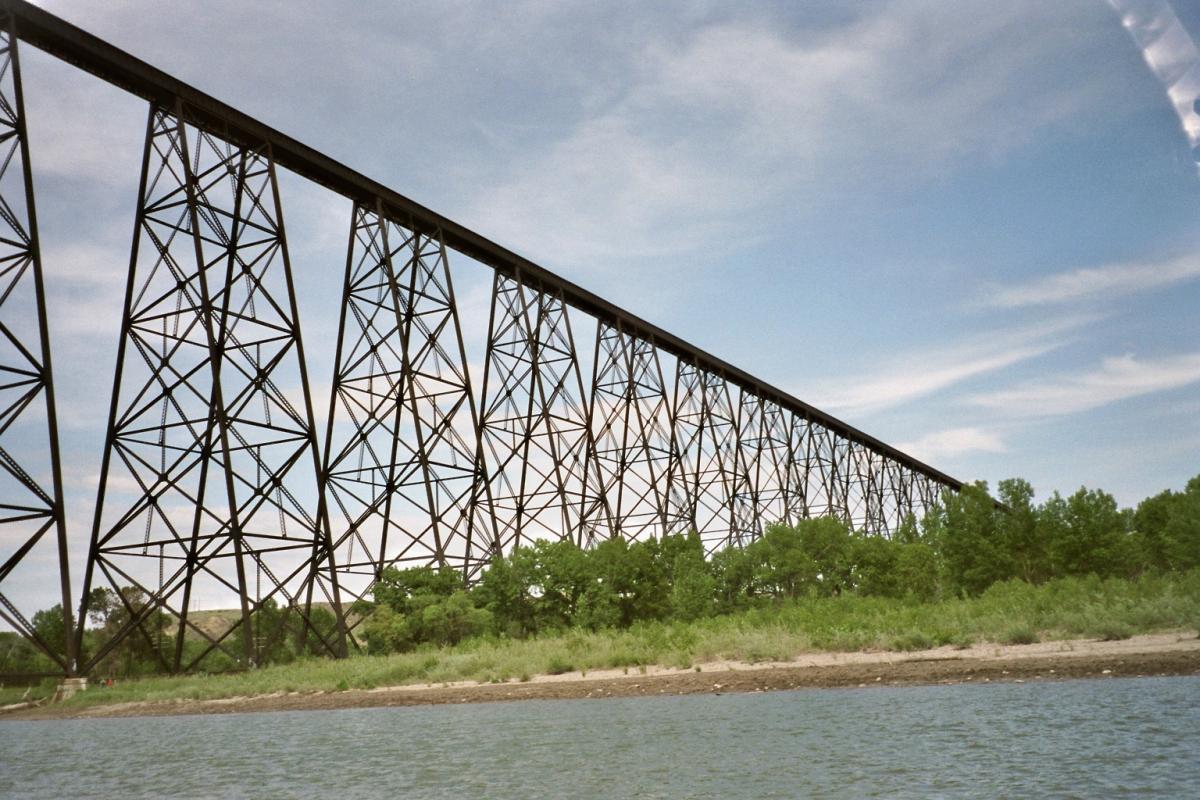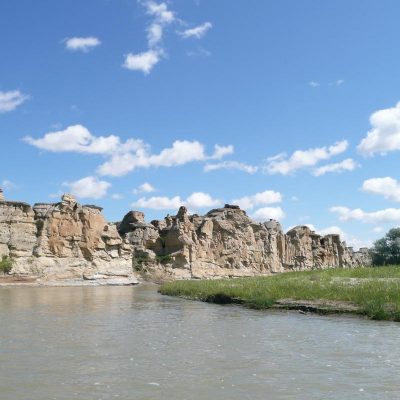“We live on a continent and a planet, that is shaped by storms, whether they be the slow but unrelenting waters of a rising Red River, the abrupt violence of a tornado, or the massive force of a hurricane,” observed Creation Care Council Member Joanne Moyer as she addressed the 2014 Mennonite Church Canada Assembly during a worship service. The theme of the assembly was Wild Hope.
Meditation
Joanne Moyer
Mennonite Church Canada Assembly
Saturday, July 5, 2014
Rivers pictured here are the Milk River, left, and the Old Man River, in text. The formations in the top photo are called hoodoos.
Tonight, we are gathered on the banks of the Assiniboine River, the swelling Assiniboine River. We have spent our entire weekend within the Red River Valley. A defining characteristic of this watershed is its tendency to flood. Everyone who lives near the river is accustomed to the yearly worry about spring flooding, damage to homes and buildings, and disruption to agricultural activities, particularly along the Red. Several years ago, the Assiniboine flooded and you can still see the marks on the trees and changes in vegetation in the woods beyond the dike nearby. And of course, there was all that rain last weekend, and now it is flooding again.
Within our larger watershed, the Hudson’s Bay drainage basin, our neighbours in Alberta have also been suffering flooding recently. If you canoed along this river into Lake Winnipeg, and then went back upstream along the Saskatchewan River, you would reach the rivers that flow out of the Rockies, like the Bow that swelled so suddenly and dangerously in Calgary last summer, and the Old Man, that nearly filled the river valley in my home town of Lethbridge just last month.
 Near the Old Man, you can portage across the continental divide, and enter the Missouri River system on the Milk River. The Missouri flows through Nebraska and Kansas, an area renowned for tornadoes, and then into the Mississippi and the Gulf of Mexico, home of hurricanes. We live on a continent, and a planet, that is shaped by storms, whether they be the slow but unrelenting waters of a rising Red River, the abrupt violence of a tornado, or the massive force of a hurricane.
Near the Old Man, you can portage across the continental divide, and enter the Missouri River system on the Milk River. The Missouri flows through Nebraska and Kansas, an area renowned for tornadoes, and then into the Mississippi and the Gulf of Mexico, home of hurricanes. We live on a continent, and a planet, that is shaped by storms, whether they be the slow but unrelenting waters of a rising Red River, the abrupt violence of a tornado, or the massive force of a hurricane.
These storms have always been part of our lives; they fill us with awe, and they fill us with fear, and they remind us that both God and nature are bigger than we are. We see in storms a brief glimpse of the chaos that existed before creation, and when they end, and the rainbow forms, we see how God, the Creator, and Jesus, the storm calmer, the Word who was with God in the beginning, bring order to that chaos.
Yet, chaos still threatens. We see it lurking in our community dilemmas, in violent human conflicts around the world, and in the actual storms, like the ones last weekend, that we continue to experience. Assuming the predictions of our best climate scientists are correct, all of these storms are about to get bigger, as planetary temperatures rise, climatic patterns are disrupted, and extreme weather events increase.
Shaping an appropriate response to that particular storm, the storm of climate disruption and chaos, may be the greatest challenge of our time. We are challenged by uncertainty about the science and the forecasts it makes. We are challenged by our North American luxury and comfort, which often cushion us from the harshest blows, and which can blind us to the need of others. At the same time, we are challenged by our fears for economic welfare and security in the present and in the future. And we are overwhelmed by the need for solutions that are so complex, they are far beyond the capacity of one person or one community.
As we wrestle with these challenges, we must first remember that we are all connected. We are connected through the wind and water systems, the rivers that flow across our lands, and the ocean currents that connect our continents. We are connected by the geese that herald spring as they fly through our skies on their way from the southern US to their northern breeding grounds. We are connected by the monarch butterflies that migrate from our backyards to forests in Mexico. And we are connected by the people, our brothers and sisters, whose homes and farms are soaked by floods, smashed by tornadoes, washed away by hurricanes, and withered by drought. We are connected to them through our Mennonite Disaster Service Teams who help rebuild their houses, and our Mennonite Central Committee projects that work across the world to bring water and food security. And we are connected through our shared humanity, and shared life on this planet, a planet created by a God who loves us all, and God’s son, who came to redeem us, and comfort us in the storm. Because we are connected, because we are people of faith, we must keep caring and searching for solutions.
As we wrestle with these challenges we must also remember that like the disciples, we have Jesus, the first born of all creation, the redeemer of the world, and the man who could command the wind and sea, in the boat with us. Ephesians 3:20 says: “Now to him who by the power at work within us is able to accomplish abundantly far more than all we can ask or imagine, to him be glory.” No matter what the dire forecasts and gloomy reports tell us, Jesus is with us, and therein we can find hope, the hope we need to carry on, and to meet all the struggles and storms that assail us, with courage, hard work, and faithfulness.
posted with permission by MCCN on September 1, 2014
